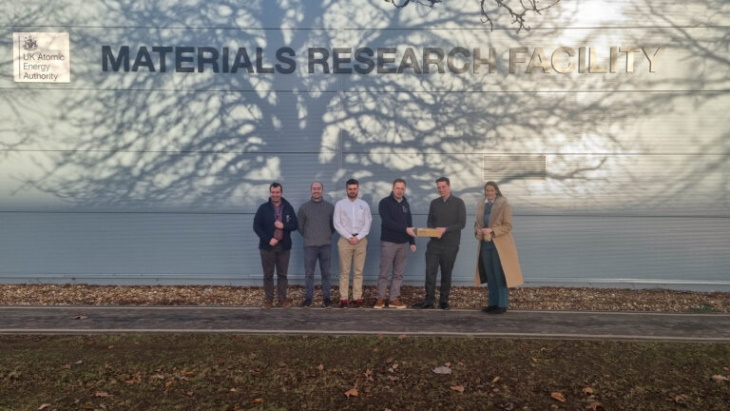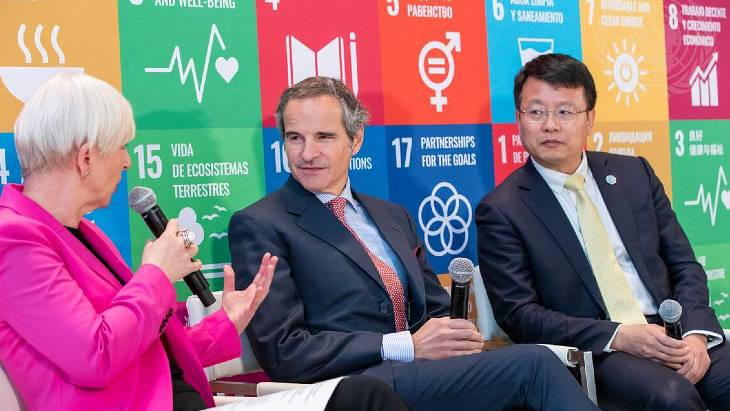UK-Japanese partnership to develop fusion materials
23 March 2023
A collaboration agreement has been signed between Japan's Kyoto Fusioneering (KF) and the UK Atomic Energy Authority (UKAEA) to develop fusion related technologies. The first project under the collaboration will be the development of a 'fusion-grade' silicon carbide composite system.
 A specimen of 'fusion grade' silicon carbide composite made by KF in Japan being handed over to UKAEA for experimentation (Image: UKAEA/KF)
A specimen of 'fusion grade' silicon carbide composite made by KF in Japan being handed over to UKAEA for experimentation (Image: UKAEA/KF)"The collaboration reaffirms the strategic partnership between the United Kingdom and Japan and is based on a mutual commitment to deliver sustainable, commercial fusion energy for generations to come," the partners said.
KF and UKAEA said that as a first step they will develop a silicon carbide composite system (SiC/SiC) suitable for use as a structural material inside a fusion machine and to understand its stability under simulated fusion conditions.
The use of SiC/SiC composites within the breeder blanket of a fusion machine will increase the efficiency and commercial viability of fusion power stations by providing a material that operates at high temperatures and is resistant to neutron damage, they noted.
The Self-Cooled Yuryo Lithium Lead Advanced (SCYLLA) blanket developed by KF is compatible with the lithium-lead based coolant and fuel breeding fluids.
Examination of irradiated composites can only be carried out in a suitable active testing facility and KF has looked to UKAEA's Materials Research Facility (MRF) for support.
New post-irradiation examination methods are being developed by UKAEA to understand the changes in microstructural properties of the SiC/SiC samples caused by radiation damage. As a fibre-reinforced composite, some novel methods need to be used to extract useful material properties.
Under the new agreement, KF will accelerate the development of critical plant components catered to the needs of other fusion companies around the world.
KF already has several contracts awarded by UKAEA to provide its expertise and services, most notably being appointed in August 2022 as a member of the Spherical Tokamak for Energy Production (STEP) Interim Engineering Delivery Partner consortium. KF was also selected as a Tier 1 supplier in 2021 under the UKAEA Tritium Engineering Framework for the STEP fuel cycle.
"The several contracts we have with UKAEA have demonstrated the win-win relationship that can create new value for the society and fusion research and fusion industry," said Kyoto Fusioneering CEO Taka Nagao. "Kyoto Fusioneering will continue to build on our successful technology collaboration to help achieve industrialisation of fusion energy.
"The development of a 'fusion-grade' silicon carbide composite system is not only a huge advancement to the realisation of commercial fusion, but also yet another advantage of the blanket system, which is so important in our collective battle against climate change."
"This collaboration agreement builds on our existing relationship," added UKAEA CEO Ian Chapman. "Putting fusion electricity on the grid requires finding and integrating solutions to several major challenges and we will be working with Kyoto Fusioneering on finding solutions to some of those challenges."
UKAEA has signed several agreements over the past few months to collaborate on the development of fusion technology. These include a strategic research partnership with the US Department of Energy's Oak Ridge National Laboratory to better understand the performance and behaviour of materials required for use in future commercial fusion power plants. UKAEA also signed a five-year framework agreement with Tokamak Energy for closer collaboration "on developing spherical tokamaks as a route to commercial fusion energy". It also signed agreements with the University of Sheffield and the University of Birmingham to collaborate on fusion R&D.
Researched and written by World Nuclear News
 The IAEA's Grossi, centre, and the FAO's Lifeng Li, right, discussed water action at the UN 2023 Water Conference (Image: UN Photo/Paulo Figueiras)
The IAEA's Grossi, centre, and the FAO's Lifeng Li, right, discussed water action at the UN 2023 Water Conference (Image: UN Photo/Paulo Figueiras).jpg?ext=.jpg) Jennifer Granholm sees a demonstration of X-energy's 3-D virtual reality plant at the ARPA-E Energy Innovation Summit recently (Image: X-energy's Twitter)
Jennifer Granholm sees a demonstration of X-energy's 3-D virtual reality plant at the ARPA-E Energy Innovation Summit recently (Image: X-energy's Twitter).jpg?ext=.jpg) A power plant based on Last Energy's micro reactor technology (Image: Last Energy)
A power plant based on Last Energy's micro reactor technology (Image: Last Energy).jpg)
.jpg?ext=.jpg) (L-R) Wileman, Lyash, Hartwick and Kasprów signed the agreement (Image: @TVANews)
(L-R) Wileman, Lyash, Hartwick and Kasprów signed the agreement (Image: @TVANews).jpg?ext=.jpg) ARC announced the signature of the MoU on 23 March (Image: @arc_cleantech)
ARC announced the signature of the MoU on 23 March (Image: @arc_cleantech).jpg?ext=.jpg) Premier Peter Malinauskas (standing) watches as Flinders University Vice-Chancellor Colin Stirling (left) and Clint Sharrad, interim director of the Dalton Nuclear Institute at the University of Manchester, sign the partnership agreement. (Image: Flinders University)
Premier Peter Malinauskas (standing) watches as Flinders University Vice-Chancellor Colin Stirling (left) and Clint Sharrad, interim director of the Dalton Nuclear Institute at the University of Manchester, sign the partnership agreement. (Image: Flinders University)